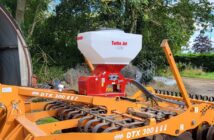Higher commodity prices, better yields and lower variable costs saw returns from Contract Farming Agreements rise for both the farmer and the contractor in 2017.
Provisional results from Strutt & Parker’s annual survey of Contract Farming Agreements, which covers 18,700ha of land mainly in the East of England, East Midland and South East England, showed the average net margin from agreements for Harvest 2017 was £125/ha higher than for Harvest 2016.
Speaking at the Cereals Event, Richard Means, director in the farming department of Strutt & Parker, said total returns to the farmer averaged £353/ha in 2017 (£273/ha in 2016), which is around the five-year average.
The contractor’s total income was very similar to that of the farmer at £367/ha (£311/ha in 2016), up from the lows of 2015 and 2016, although still below the 10-year average.
“It is really pleasing to see an upturn in the total returns to both parties, compared with 2016 thanks to higher crops prices and better yields, and all despite a significant area of oilseed rape in the east and south east of England being written off during autumn 2016,” he said.
“Another factor was the drop in variable costs which were at their lowest level since 2011 as a result of lower fertiliser costs, reduced fungicide expenditure in the dry 2017 spring and the OSR crops being replaced by lower input crops.
“What is also very positive is to see an increase in the divisible surplus, which is the revenue that can be divided between the farmer and contractor after variable costs, fixed costs, the contractor’s charge and farmer’s retention have been deducted from total receipts.
“In 2015, more than half of agreements made a negative divisible surplus, in 2016 this was 39%, but in 2017 this figure was down to 11%. In our mind, a good contract farming agreement is where you make a positive divisible surplus – because it shows it is a sustainable agreement where the contractor’s charge and farmer’s first charge are set at an achievable level and having a positive divisible surplus generates the incentivisation necessary for the contractor to benefit from the work that they have put in during the year.”
Mr Means said in instances where there was a negative divisible surplus, agreements should be structured so the losses were carried entirely by the farmer, as it showed they were taking on the risks associated with farming.
“We do hear about arrangements where it is agreed that any losses are rolled forward to future years and we think this is potentially quite dangerous as that guarantees a minimum return to the farmer in any one year, which could be seen as a rent.”
Future trends
Mr Means said interest in Contract Farming Agreements remained strong – from both sides.
CFAs could be a good option for farmers looking to improve their efficiency by cutting their labour and machinery requirements, while retaining the tax advantages of being a trading business.
However, there had been a trend over the past few years for contractors to receive a higher contractor’s charge, which is fixed, and then a lower first split of any divisible surplus.
This shift was a way of protecting contractors from market volatility and secure a higher return, and means that the farmer bears a greater proportion of the risk from trading.
“The contractor needs more of a guarantee of what they will get so is seeking a slightly higher contractor’s charge. But in exchange they are obviously trading some of the potential uplift they might get from any higher divisible surplus when prices and yields align, which is now moving back towards being split 50:50 between farmer and contractor.”
Mr Means said this was a trend that was continuing as agreements were renegotiated, with even more volatility expected in the future.
This is due to the widening of the ban on neonicotinoids which could make crop yields more variable, the expected drop in Basic Payments and the introduction of the new generation of agri-environment schemes which could be based on environmental outcomes, so could be less predictable in terms of income.
The government’s plans to move towards the payment of ‘public money for public goods’ also make it likely that farmers and contractors will want to review their agreements to establish incentives for high quality environmental management, which could become as important as high quality crop management.
Strutt & Parker Harvest 2017 provisional CFA results (combinable crops agreements only) – A summary
- Total receipts from crops sales, BPS and stewardship payments 9% higher than in 2016 at £1,204/ha, due to slightly higher commodity prices and yields.
- Average variable costs (£391/ha) were lowest since 2011 as a result of lower fertiliser costs, reduced fungicide expenditure in the dry 2017 spring and failed OSR crops being replaced by lower input crops.
- Fixed costs stable at £103/ha.
- Contractor’s charge broadly similar to 2016 at £269/ha, leaving a net margin of £441/ha.
- Farmer’s retention £273/ha (£247/ha in 2016), leaving an average divisible surplus of £168/ha (£68/ha in 2016).
- Total returns to the farmer averaged £353/ha (£273/ha in 2016), which is around the five-year average, but there is wide variation (from under £200/ha to near £600/ha).
- Contractor’s total income was £367/ha (£311/ha in 2016), which is around the five-year average.
Strutt & Parker Harvest 2017 provisional CFA results (including root crop agreements) – A summary
- Total receipts from crops sales, BPS and stewardship payments higher than in 2016 at £1,294/ha, but below the five-year average.
- Average variable costs up from £363/ha in 2016 to £372/ha in 2017.
- Fixed costs £142/ha (£153 in 2016).
- Contractor’s charge down at £256/ha (£268/ha in 2016), leaving a net margin of £524/ha.
- Farmer’s retention £331/ha (£365/ha in 2016), leaving an average divisible surplus of £194/ha.
- Total returns to the farmer averaged £418/ha (£387/ha in 2016).
- Contractor’s total income was £364/ha (£316/ha in 2016).




